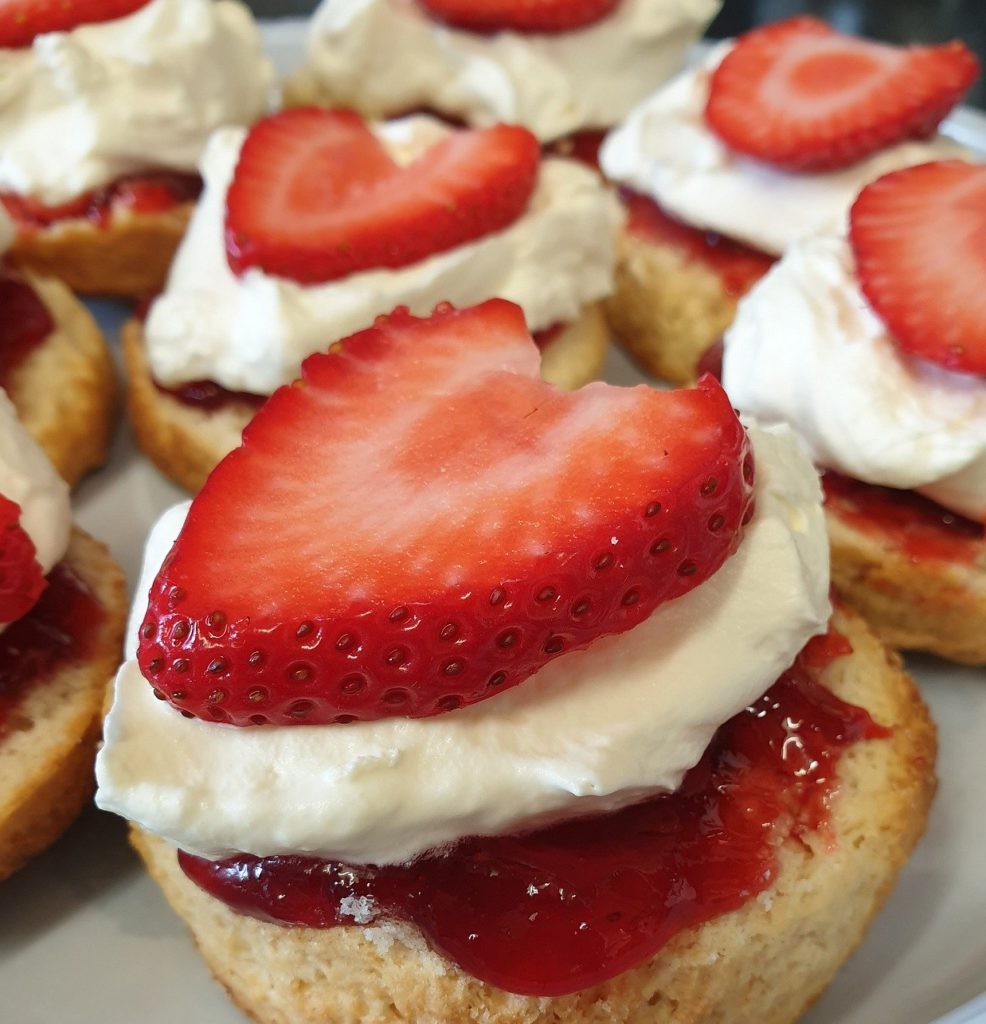Scones and Tea – The Perfect Company

It’s National Cream Tea Day on 25 June. It’s a classic British tradition, and with its own official day of celebration, it would be rude not to enjoy one or two. Of course, a good pot of loose-leaf tea should always accompany a delicious scone with clotted cream and jam – strawberry is favourite.
When exactly it became known as a cream tea is hard to establish. Some say that it originated in Tavistock Abbey in Devon, as early as the 11th century (admittedly using bread instead of a scone), others quote it being 1662. Many say it was the 1850s, when tourism to the South West of England boomed, due to new railway access.
Yet, the biggest debate of all may never be solved.
The Big Cream Tea Debate
It turns out that the scone may just be the most controversial baked good of our time.
The Cornish, the Devonshire, the royal or simply the scientific way? What way is best to layer the jam and cream?
The Cornish Cream Tea
The Cornish people have a saying; ‘don’t treat your clotted cream like butter and your scone will be all the better’. So, clearly that means they think it should be jam first and then clotted cream on top.
The Devonshire
Whereas a Devonshire cream tea consists of clotted cream first, followed by a dollop of jam.
The esteemed etiquette gurus, Debrett’s say you should spread your jam before dolloping cream on top. Therefore, agreeing with the Cornish version of a cream tea.
The Royal Preference
The Queen also prefers jam first. According to a former chef who worked for the royal family from 1982 to 1993.
“Jam first at Buckingham Palace garden parties!” Darren McGrady wrote on Twitter.
“The Queen always had homemade Balmoral jam first,” the chef and author added in a subsequent tweet, “with clotted cream on top at Buckingham Palace garden parties in the royal tea tent and all royal tea parties.”
The reason for these Tweets was in response to the uproar that had been caused by a Cornish National Trust venue. A photo of Devonshire cream teas (cream first) was used when promoting a Mother’s Day event on social media. Locals were outraged, whereas Devonians delighted in the fact that ‘even a Cornish venue thinks this is the correct way’.
The Scientific Cream Tea
Science seems to prefer the Devonshire cream tea.
It was reported in The Daily Telegraph that food scientist Dr Stuart Farrimond and baker Mich Turner worked out that using cream first, achieves the perfect 4:3:3 ratio and makes application easier.
The ratio is a 40g scone with 30g of cream and then 30g of jam. It ‘will achieve the ‘hedonic breakpoint’: the ideal level of sweetness (around 28% per mouthful) from the jam, balanced out by the cool cream and simple scone’.
We think that you should throw the arguments out of the window and simply eat a cream tea whichever way you enjoy best!
Of course, the choice of tea to accompany your scone(s) is the thing that we are passionate about.
TRY THESE WITH YOUR NEXT CREAM TEA:
English Afternoon Tea
Our very own Afternoon Tea blend. A fine combination of China and Darjeeling teas with a hint of Lapsang Souchong giving slight touch of smokiness. Smooth and easy. The ideal companion for a cream tea.
Royal Earl Grey
A particularly refined Earl Grey enhanced by royal blue mallow flowers resulting in an exceptional tea. Fragrant and light, the underlying blend is Ceylon and China. Enjoy with or without milk. Earl Grey has grown in popularity since first named for the 2nd Earl Grey in the early 19th century and is now famous worldwide as one of Britain’s most iconic blends.
Lapsang Souchong Superior
A higher grade Lapsang made from best quality Souchong leaves. The large lower leaves of the tea plant (‘Souchong’ leaves) are smoked over pine wood rich in resin. This yields the classic smokiness with a spicy touch.
Royal Afternoon Tea
The leaves of this black “gunpowder” tea are tightly rolled up resembling delicate black pearls (or gunpowder pellets). As they infuse, the pearls unfurl and release their exquisite flavour. Aromatic and mild taste yet with good body, well suited to accompany any cream tea.
A final word. One thing we must agree on is never to use whipped cream. It must always be clotted!
Let us know your favourite tea to create the perfect cream tea and how you prefer to dress your scones @theteahouseltd.

I actually prefer plain butter scones, with a layer of hazelnut chocolate spread, and then topped with a dollop of freshly whipped cream – a variant I discovered when visiting my partner in Hull some years back.
This with an Earl Grey Citrus, or Blood Orange flavoured black, is my personal favourite “cream tea” indulgence.